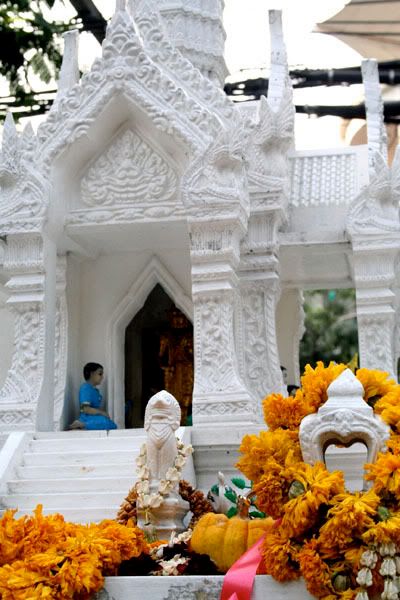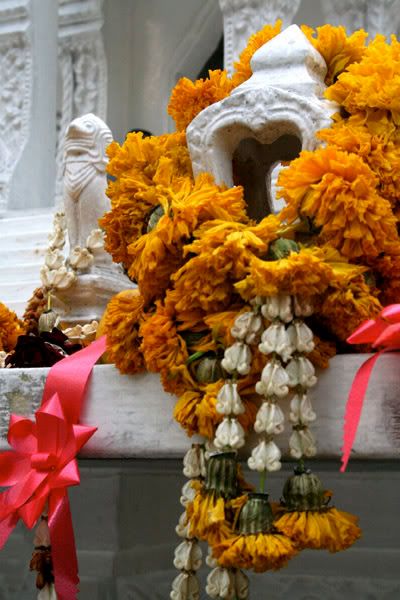 After I started the series on the gods and spirits of Thong Lo, I realized that it was in part a way of working out some thoughts about modernity and globalization in Thailand. It's a topic that's been on my mind recently, but it's something I've been thinking about for years, since I first learned of spirit-houses.
After I started the series on the gods and spirits of Thong Lo, I realized that it was in part a way of working out some thoughts about modernity and globalization in Thailand. It's a topic that's been on my mind recently, but it's something I've been thinking about for years, since I first learned of spirit-houses.I first became familiar with them during college, while living in Los Angeles. I ate out infrequently in Thai Town, a nondescript area of Hollywood with a lot of hole-in-the-wall Thai restaurants. Some of the grander properties had shrines out front: small but beautiful Thai-style houses, laden with fresh fruit and draped in flowers.
In 2003, I was assigned a sculpture project on pattern making. Since I had no experience with sewing patterns, I opted to go for something architectural. For some reason, my mind turned back to the elaborate shrines I had seen in Thai Town. I researched them, and learned that they were called spirit-houses: miniature homes meant to provide a refuge for spirits that were displaced when people developed land. People tend the houses, offering food and drink to the spirits that reside within. I read that spirit-houses used to be made mostly out of wood, but as development in Southeast Asia exploded and the forests thinned, they were increasingly being made out of concrete. The connections between ideas of displacement, modernization, and loss of tradition intrigued me. For my sculpture project, I built a spirit-house out of used cardboard. It was a Coca-Cola spirit house, with red and white soda-pop tiles dripping over a cardboard frame.
 Recently, I read an interview with an Australian photographer about his work in Thailand. The photographer complained about Bangkok, how he had come looking for the exotic, and found a city just like every other. He lamented the loss of tradition, which he saw as the result of consumption and consumerism. He felt that soon Thai culture would disappear completely in the face of Western influence. While I too have nostalgic feelings about the loss of traditional cultures, and understand that hegemonic forms of globalization are troubling, his comments annoyed me. In part, I simply disagree with him about Bangkok; it's an extraordinary city that is just as unique as it is global. Beyond that, I think that it's a colonizing gesture to look at an 'exotic' culture, and wish for it to remain 'traditional'- while he likely doesn't expect the same of his own. But most strikingly, I found his suggestion that Thai culture is something static, able to be bulldozed in place of something new, to be completely incorrect. Thai culture (like most cultures) is inherently dynamic. Part of what makes Thai culture so vibrant is the degree to which it is a result of the merging of different cultures. Thai cuisine, which seems so distinct, is largely the collision of local, Khmer, Chinese, Indian, and even Portuguese (in the desserts, anyway) influences. Globalization isn't something that's going to wipe out Thai culture- it's what's gave birth to Thai culture in the first place.
Recently, I read an interview with an Australian photographer about his work in Thailand. The photographer complained about Bangkok, how he had come looking for the exotic, and found a city just like every other. He lamented the loss of tradition, which he saw as the result of consumption and consumerism. He felt that soon Thai culture would disappear completely in the face of Western influence. While I too have nostalgic feelings about the loss of traditional cultures, and understand that hegemonic forms of globalization are troubling, his comments annoyed me. In part, I simply disagree with him about Bangkok; it's an extraordinary city that is just as unique as it is global. Beyond that, I think that it's a colonizing gesture to look at an 'exotic' culture, and wish for it to remain 'traditional'- while he likely doesn't expect the same of his own. But most strikingly, I found his suggestion that Thai culture is something static, able to be bulldozed in place of something new, to be completely incorrect. Thai culture (like most cultures) is inherently dynamic. Part of what makes Thai culture so vibrant is the degree to which it is a result of the merging of different cultures. Thai cuisine, which seems so distinct, is largely the collision of local, Khmer, Chinese, Indian, and even Portuguese (in the desserts, anyway) influences. Globalization isn't something that's going to wipe out Thai culture- it's what's gave birth to Thai culture in the first place. The spirit-houses themselves are actually a great symbol of resilience. Buddhism is, after all, a foreign import- and the spirit-houses that link back to older traditions managed to survive. Thong Lo is one of the city's youngest, hippest, most moneyed streets in Bangkok- and yet people still create spaces for gods and spirits among the luxury condos and cutting-edge shopping malls. The spirits of Thong Lo don't linger as relics of a 'traditional' past, but thrive as living forces in the lives of modern people. And really, aren't spirit-houses about making way for something new while not losing touch with the old?
The spirit-houses themselves are actually a great symbol of resilience. Buddhism is, after all, a foreign import- and the spirit-houses that link back to older traditions managed to survive. Thong Lo is one of the city's youngest, hippest, most moneyed streets in Bangkok- and yet people still create spaces for gods and spirits among the luxury condos and cutting-edge shopping malls. The spirits of Thong Lo don't linger as relics of a 'traditional' past, but thrive as living forces in the lives of modern people. And really, aren't spirit-houses about making way for something new while not losing touch with the old?In the end, my thoughts came back to the spirit-house that I had made nearly five years ago. I don't think I fully understood what I meant when I created that Coca Cola spirit-house, but perhaps I know better now. I had made the spirit house out of non-traditional elements, out of ugliness. I thought it might be an indictment against modernization, but in the end, it was a beautiful object, with lush red and green tiles glistening over an ornate corrugated frame. The beauty of my recycled spirit-house had a meaning I hadn't intended. The materials and tastes of a culture may change, but isn't it possible that the spirit stays the same?

7 comments:
Great post. And I agree about the photographer's comments (is the interview online?) - shocking, really. Did he photograph with his eyes closed?
Thai culture is incredibly resilient, and whenever I visit Bangkok I am struck by the fact that however much the city has morphed in quest of 'development' and 'modern-ness' as it's defined globally, it remains thoroughly, absolutely Thai.
Learn something new every day.
A
Great stuff. I'm interested in the thoughts and perspectives from the people who have spent time living in a place ruminating on these issues as opposed to those who have expectation to be lazily treated to a feast of the "exotic" before rushing on to the next place. Maybe this says something about the growth and ease of international travel.
i actually got into a pretty strong argument with a Canadian fellow for telling me that he was amazed I'd lasted in Bangkok so long. "It's not the real thailand" he informed me. A friend from Bangkok sitting next to me had different thoughts on the matter.
A couple of thoughts arise after reading your interesting post:
Both in Thailand and in Mauritius, I was really struck by the way the spiritual is part of peoples’ everyday lives. There’s always a garland or spirit house in your vision and the scent of incense in the air. It wasn’t something I knew was missing from my culture until I saw it there.
Something also new for me in Thailand was that maintaining ancient buildings is not about preservation or restoration of the past, which is what I’m used to. Instead, it seems that the traditional skills that went into creating the old buildings are still in general use, and so they get applied in a maintenance way, rather than a restoration way. Does that make sense? It seems that the past is carried through into the present rather than being placed in a specimen case.
Liked your comment about the green girl, btw.
This is such a wonderful post. I agree with you about the photographer's comments-- who gave him the authority to decide how the world should be?!? Anyway, I love your descriptions of the spirit houses and how they are a means to hold on to the old while embracing the new. And the last line, about the spirit always being the same...... awesome.
a's comment reminds me of an acquaintance here in KL, a fellow American, who complains that Malaysia is boring in comparison to more 'exotic' cities like Bangkok!
Yikes - what can you say to something like that?
Wow, thanks for all the responses everyone. Usually I keep from writing such long entries, since I can't imagine that anyone actually reads them.
Robyn- unfortunately, the article doesn't appear to be online. It was a short interview in the print version of the BK magazine (www.bkmagazine.com), to coincide with the opening of the photographer's show.
a- It annoys me endlessly when people make statements like that. It reminds me of how people so often say that Cape Town "isn't really Africa." I always think that maybe they need to expand their narrow definitions, which I believe would involve confronting some preconceptions and prejudices.
Heather- I think your point about not becoming museum pieces is rather apt. I think that's true of most people's lives, too- should they remain museum pieces just to satisfy other people's desire for the exotic?
-X
Post a Comment